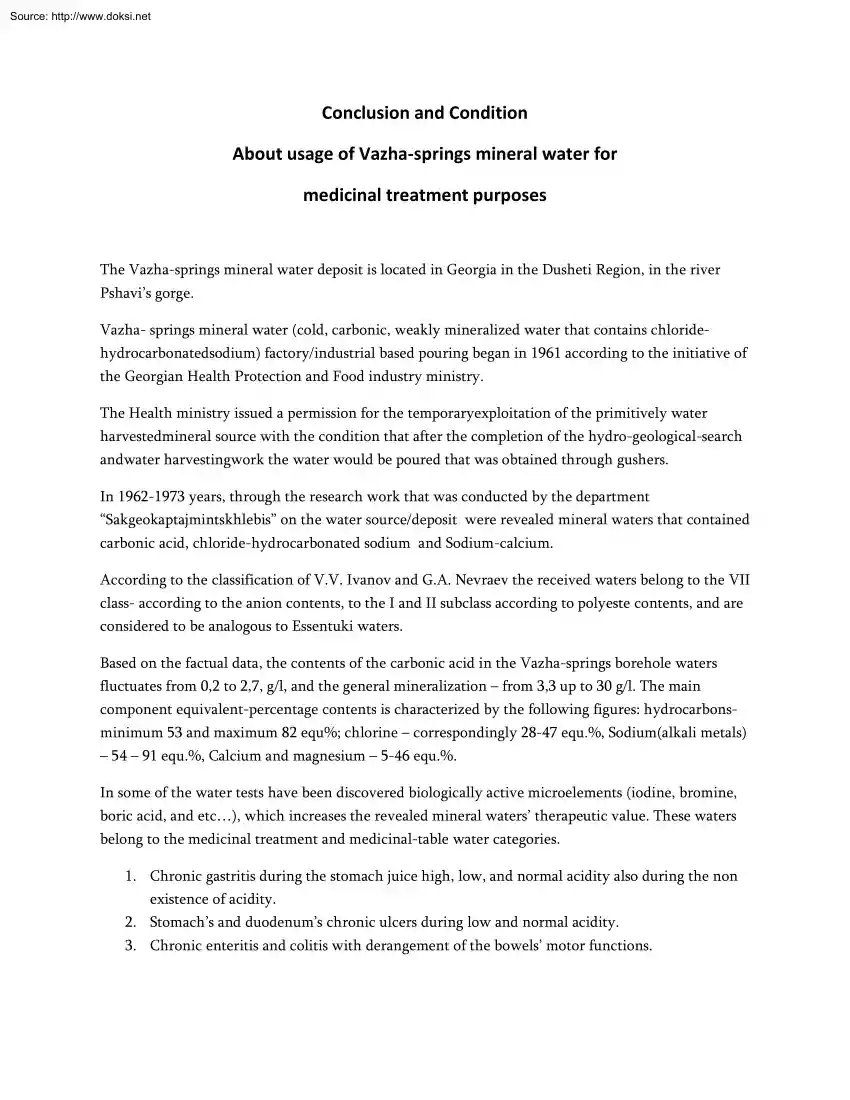A doksi online olvasásához kérlek jelentkezz be!

A doksi online olvasásához kérlek jelentkezz be!
Nincs még értékelés. Legyél Te az első!
Tartalmi kivonat
Source: http://www.doksinet Conclusion and Condition About usage of Vazha-springs mineral water for medicinal treatment purposes The Vazha-springs mineral water deposit is located in Georgia in the Dusheti Region, in the river Pshavi’s gorge. Vazha- springs mineral water (cold, carbonic, weakly mineralized water that contains chloridehydrocarbonatedsodium) factory/industrial based pouring began in 1961 according to the initiative of the Georgian Health Protection and Food industry ministry. The Health ministry issued a permission for the temporaryexploitation of the primitively water harvestedmineral source with the condition that after the completion of the hydro-geological-search andwater harvestingwork the water would be poured that was obtained through gushers. In 1962-1973 years, through the research work that was conducted by the department “Sakgeokaptajmintskhlebis” on the water source/deposit were revealed mineral waters that contained carbonic acid,
chloride-hydrocarbonated sodium and Sodium-calcium. According to the classification of V.V Ivanov and GA Nevraev the received waters belong to the VII class- according to the anion contents, to the I and II subclass according to polyeste contents, and are considered to be analogous to Essentuki waters. Based on the factual data, the contents of the carbonic acid in the Vazha-springs borehole waters fluctuates from 0,2 to 2,7, g/l, and the general mineralization – from 3,3 up to 30 g/l. The main component equivalent-percentage contents is characterized by the following figures: hydrocarbonsminimum 53 and maximum 82 equ%; chlorine – correspondingly 28-47 equ.%, Sodium(alkali metals) – 54 – 91 equ.%, Calcium and magnesium – 5-46 equ% In some of the water tests have been discovered biologically active microelements (iodine, bromine, boric acid, and etc), which increases the revealed mineral waters’ therapeutic value. These waters belong to the medicinal treatment and
medicinal-table water categories. 1. Chronic gastritis during the stomach juice high, low, and normal acidity also during the non existence of acidity. 2. Stomach’s and duodenum’s chronic ulcers during low and normal acidity 3. Chronic enteritis and colitis with derangement of the bowels’ motor functions Source: http://www.doksinet Liver and gall-bladder pathway illnesses: 1. Chronic hepatitis, Cholecystitis 2. Gall blader pebble illness without corking of the gall-bladder paths Urinary path illnesses: 1. Chronic cistidis and pyelitis with urine acidic reaction 2. Light and intermediate weight sugar diabetes Concomitant/Accompanying illnesses 1. Heart-blood vessels system illnesses: a) I degree atherosclerosis cardio-sclerosis b) I degree myocardial dystrophy c) Neurasthenia (Nervous breakdown) and etc Based on the abovementioned, it is necessary to determine for Vazha-springs carbonic acid mineral waters allowed content limit for main components. I. For waters, which are
used for medicinal treatment in the form of baths. a) General mineralization – up to 35 g/l b) Carbonic acid – more than 0,7 g/l c) Hydrocarbon ion – 50-90 equ.% d) Chlorine-ion – 25-50 equ.% e) Sodium – 60-95 equ.% II For waters, which are used for drinking-medicinal treatment: a) General Mineralization – 5-15 g/l b) Carbonic acid – 0,5-2,7 g/l c) Hydrocarbon ion – 55-90 equ.% d) Chlorine-ion – 25-45equ.% e) Sodium – 50-90 equ.% f) Calcium – up to 35 equ.% Source: http://www.doksinet For industrial pouring (medicinal treatment and medicinal-table water)it is recommended that main components fluctuate between the following margins: a) General Mineralization – 2-12 g/l b) Carbonic acid – 0,2 g/l and more c) Hydrocarbon ion – 50-90 equ.% d) Chlorine-ion – 25-50 equ.% e) Sodium – 50-90 equ.% f) Calcium – up to 10-35 equ.% In the Vazha-springs mineral waters contents of the harmful for human beings microelements should not exceed norms that are
determined by the state standards. Coli indexin the watershould not be less than 333. The exploitation regime of Vazha-springs mineral water is mainly related to drifting of the water. In case of necessity it is possible to execute forced withdrawal (pumping out) in such a regime, which will allow the chemical composition of the water to remain stable. Doctor of medicine V.G Anikashvili Doctor of Geology/mineralogy V.G Galiashvili
chloride-hydrocarbonated sodium and Sodium-calcium. According to the classification of V.V Ivanov and GA Nevraev the received waters belong to the VII class- according to the anion contents, to the I and II subclass according to polyeste contents, and are considered to be analogous to Essentuki waters. Based on the factual data, the contents of the carbonic acid in the Vazha-springs borehole waters fluctuates from 0,2 to 2,7, g/l, and the general mineralization – from 3,3 up to 30 g/l. The main component equivalent-percentage contents is characterized by the following figures: hydrocarbonsminimum 53 and maximum 82 equ%; chlorine – correspondingly 28-47 equ.%, Sodium(alkali metals) – 54 – 91 equ.%, Calcium and magnesium – 5-46 equ% In some of the water tests have been discovered biologically active microelements (iodine, bromine, boric acid, and etc), which increases the revealed mineral waters’ therapeutic value. These waters belong to the medicinal treatment and
medicinal-table water categories. 1. Chronic gastritis during the stomach juice high, low, and normal acidity also during the non existence of acidity. 2. Stomach’s and duodenum’s chronic ulcers during low and normal acidity 3. Chronic enteritis and colitis with derangement of the bowels’ motor functions Source: http://www.doksinet Liver and gall-bladder pathway illnesses: 1. Chronic hepatitis, Cholecystitis 2. Gall blader pebble illness without corking of the gall-bladder paths Urinary path illnesses: 1. Chronic cistidis and pyelitis with urine acidic reaction 2. Light and intermediate weight sugar diabetes Concomitant/Accompanying illnesses 1. Heart-blood vessels system illnesses: a) I degree atherosclerosis cardio-sclerosis b) I degree myocardial dystrophy c) Neurasthenia (Nervous breakdown) and etc Based on the abovementioned, it is necessary to determine for Vazha-springs carbonic acid mineral waters allowed content limit for main components. I. For waters, which are
used for medicinal treatment in the form of baths. a) General mineralization – up to 35 g/l b) Carbonic acid – more than 0,7 g/l c) Hydrocarbon ion – 50-90 equ.% d) Chlorine-ion – 25-50 equ.% e) Sodium – 60-95 equ.% II For waters, which are used for drinking-medicinal treatment: a) General Mineralization – 5-15 g/l b) Carbonic acid – 0,5-2,7 g/l c) Hydrocarbon ion – 55-90 equ.% d) Chlorine-ion – 25-45equ.% e) Sodium – 50-90 equ.% f) Calcium – up to 35 equ.% Source: http://www.doksinet For industrial pouring (medicinal treatment and medicinal-table water)it is recommended that main components fluctuate between the following margins: a) General Mineralization – 2-12 g/l b) Carbonic acid – 0,2 g/l and more c) Hydrocarbon ion – 50-90 equ.% d) Chlorine-ion – 25-50 equ.% e) Sodium – 50-90 equ.% f) Calcium – up to 10-35 equ.% In the Vazha-springs mineral waters contents of the harmful for human beings microelements should not exceed norms that are
determined by the state standards. Coli indexin the watershould not be less than 333. The exploitation regime of Vazha-springs mineral water is mainly related to drifting of the water. In case of necessity it is possible to execute forced withdrawal (pumping out) in such a regime, which will allow the chemical composition of the water to remain stable. Doctor of medicine V.G Anikashvili Doctor of Geology/mineralogy V.G Galiashvili




